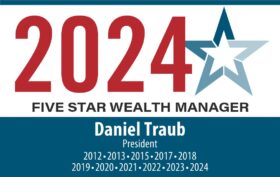The third quarter was a tale of two halves. From July 1 to August 16, the S&P 500 rose over 13%. Then, from August 17 to September 30 it fell over 16%.
The result was a loss for the quarter of 5% for the S&P 500. And there was no place to hide. International stocks were down 10% and intermediate-term bonds were down close to 5% as interest rates have continued to climb.
What happened on August 16 to turn the markets from positive to negative?
It is all about the Fed and inflation.
What changed is the consensus view that the Fed would have to raise rates more aggressively than previously thought in order to get inflation under control. Higher rates, of course, are negative for both stocks and bonds.
As you may know, the Fed has been raising the Fed Funds rate in an attempt to stem inflation. From May 5 to September 21 the Fed raised rates four times with the Fed Funds rate going from 0.75% to 3.25%.
A Fed Funds rate at 3.25% on its own wouldn’t be so bad. How much higher, and how fast we get there are the important questions.
As is always the case in this situation, the Fed is aiming for the sweet spot also known as a soft landing.
If they don’t raise rates enough, inflation will continue to rise. If they raise rates too much, that could tip the economy into a recession.
Will they get it right? I have no idea.
Do you think there will be a recession? Though I am a skeptic, almost everyone I talk to and everything I read says that we are either already in a recession or will soon be.
That is the good news. Wait. What?
The stock market is a forward-looking vehicle. It is not reacting to what is happening today, but what will happen in the future. In other words, the assumption of a recession may already be factored into the price of stocks.
While I expect short-term volatility to continue, and there certainly could be lower lows, with the markets already down between 25% and 30%, my guess is the worst of the decline may already be behind us.
Time will tell.
In the meantime, we are left to do what we always do: Invest in a portfolio that is appropriate for our individual risk tolerances and ride out the storm. Naturally, I will also tilt the risk-reward equation to our advantage by favoring segments of the stock and bond markets (and alternatives) I think will hold up better than most in this environment.
So far this year we have been quite successful at that. Read on.
Tempo Financial Advisors’ 3rd Quarter Investment Performance
You might suspect that with both U.S. stocks and bonds down 5% and international stocks down 10% in the third quarter, the benchmark for Tempo Lifestyle portfolios is somewhere between these two figures.
You would be correct. The benchmarks range from -5% for conservative accounts to -6% for aggressive accounts.
Across the board Tempo Lifestyle results were about 1% ahead of benchmarks.
Year-to-date (through 9/30/22), the S&P 500 is down 24%. International stocks and intermediate-term bonds returned -27% and -15%, respectively.
Tempo Lifestyle conservative accounts were down 15% and aggressive accounts were down 20%. This is between 3% and 5% better than benchmarks thus far in 2022.
Tempo’s active investment strategies are all having a terrific 2022. Not in terms of making money (if only!) but in terms of crushing their respective benchmarks.
As you now know, intermediate-term bonds were down 5% for the quarter and down 15% year-to-date.
Tempo Dynamic Income was up (yes up!) 0.7% in the third quarter, and Tempo Diversified Income was down 0.5%. That is outperformance between 4.5% and 5.7% in just Q3.
Year-to date returns for both strategies are down between 5% and 6%. That is between 9% and 10% better than benchmarks!
Tempo Dynamic Growth was down 1.6% in Q3 as compared to the benchmark, which was down 4.3%. Year-to-date, Dynamic Growth is down 6%, compared to the benchmark’s decline of 17%. This translates to outperformance of 2.7% in Q3 and 11% year-to date.
I am not saying you should be happy to have lost money. I know I’m not! (I invest in all the same Tempo strategies.)
I am saying that long-run success in investing is made up of small (or in some cases large) outperformances over time. From this perspective, 2022 has been a success for Tempo, and, more importantly, for Tempo’s clients!
Reminder
Please contact us if there has been a change in your financial circumstances that would warrant a fresh perspective on your portfolio.
Daniel J. Traub

